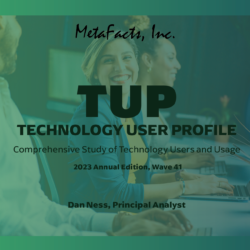Background:
Mobile computing has extended the lifetime of computer use, especially home computer use, over the last half decade. However, users are increasingly turning to their smartphones as their primary mobile device, using them for activities formerly done with home notebooks/laptops. During this same time, the pandemic and subsequent remote work bolstered home notebook/laptop purchases. Home notebook/laptop acquisition trends benefitted because many employers were reticent to provide mobile computers to employees.
The usage of home notebooks/laptops has not been evenly distributed, with brands focusing on different market segments or use cases. More recently, the push toward AI-enhanced computers has met with mixed results. The next three years will be pivotal and depend substantially on consumers’ choices for their home technology.
Approach:
This one-time TUP data cut profiles active home notebook/laptop users by brand and other dimensions. Starting with intentions to refresh their PCs within specific time frames, we profile the age of PCs in active use, the brand share of the installed base, and usage levels in hours and activities. MetaFacts further identifies the activities done most often, including remote work status.
These results are based on the MetaFacts TUP/Technology User Profile 2024 datasets, with 13,561 respondents representing online adults in the US, Germany, the UK, Japan, and China. Additional trends from 2018 through 2024 are included based on data from 84,608 respondents in the US, Germany, the UK, and Japan reporting on the penetration rates and active market size of home notebooks/laptops.
The TUP data cut features a set of standardized cross-tabulations from TUP/Technology User Profile 2024 in Excel format. It also includes trending information and a topline summary.

